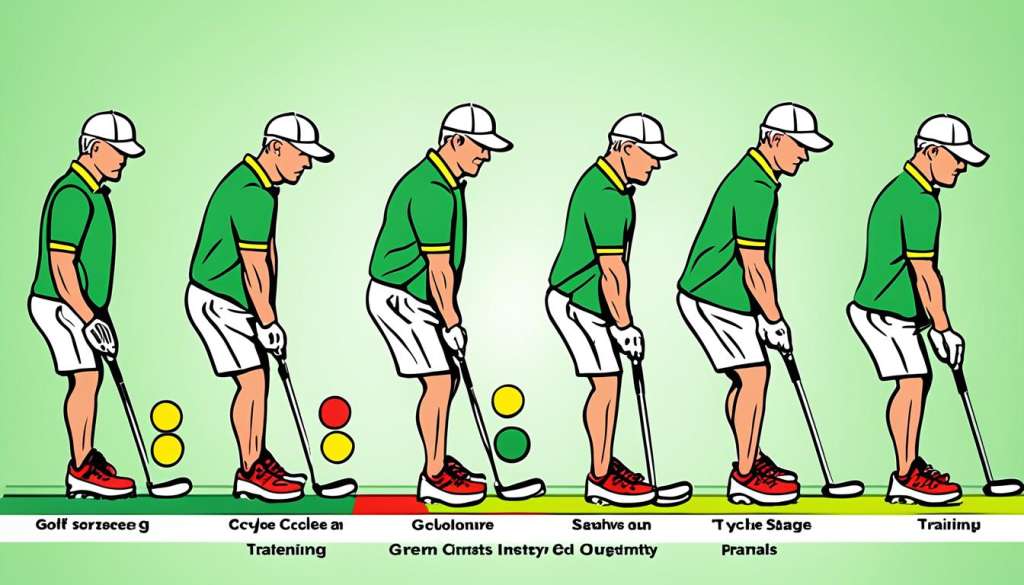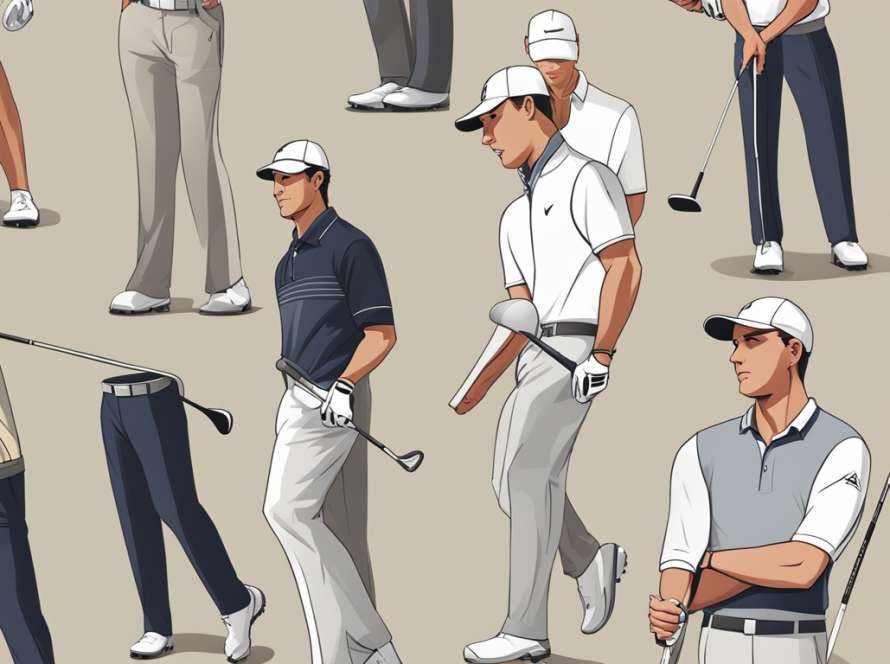Getting a golf fitness guide is key to boosting your game and avoiding injuries. It’s a complete way to improve your golf skills. By sticking to a golf training plan, you’ll get better strength, flexibility, and focus.
A good golf fitness guide meets the sport’s special needs. It mixes strength training, power exercises, and flexibility moves. This helps improve your swing and overall performance. Your plan will focus on important muscles used in golf, making you hit farther, more accurately, and consistently.
Your golf training should have a plan that changes over time. This method, called periodization, adjusts workout intensity and focus. It prepares you physically and mentally for both tournaments and casual games. Adding strength, flexibility, and mental training will make your game better and lower injury risks.
Understanding the Importance of Golf Fitness
Golf fitness is now key for golfers. They aim to boost their game with a full golf conditioning program. This method helps improve performance on the course.
The Physical Demands of Golf
Golf needs strength, flexibility, and endurance. Walking miles, swinging repeatedly, and staying focused for hours is part of the game. This shows why a good fitness plan is essential.
Benefits of a Golf-Specific Fitness Program
A golf conditioning program brings many benefits:
- Increased driving distance
- Improved swing mechanics
- Enhanced stamina for 18 holes
- Reduced risk of injury
- Better mental focus
How Fitness Impacts Your Golf Game
Your fitness level changes how you play golf. A strong core and flexible hips mean more powerful swings. Better heart health keeps you going all round. And don’t forget mental fitness, key for handling stress and making smart moves.
| Fitness Component | Golf Performance Impact |
|---|---|
| Strength | Increased clubhead speed, longer drives |
| Flexibility | Improved swing range, better posture |
| Endurance | Consistent performance over 18 holes |
| Balance | Enhanced stability during swings |
| Mental Focus | Better decision-making, stress management |
Adding a golf-specific fitness plan to your routine can boost your game. Golf physical preparation means more than just gym workouts. It’s about making your exercises fit the sport’s unique needs.
Components of a Comprehensive Golf Fitness Program
Improving your golf game requires a well-rounded exercise routine. It should cover different areas to boost your performance. Let’s look at the main parts of a complete golf fitness program.
Strength training is key for golf fitness. Focus on exercises like core rotations, squats, and shoulder presses. These help build power for longer drives and more precise shots.
Flexibility is also crucial. Include stretches for your hips, shoulders, and spine. This will make your swing smoother and more efficient.
Don’t forget about cardiovascular fitness. Regular cardio boosts endurance, keeping you focused and energetic during your game. Try activities like brisk walking, cycling, or swimming to get your heart rate up.
| Component | Benefits | Example Exercises |
|---|---|---|
| Strength Training | Increased power, improved stability | Deadlifts, lunges, medicine ball rotations |
| Flexibility | Better range of motion, smoother swing | Hip rotators, thoracic spine stretches, shoulder mobility drills |
| Cardiovascular Fitness | Enhanced endurance, improved focus | Jogging, rowing, high-intensity interval training |
| Balance and Stability | Better control, reduced injury risk | Single-leg exercises, stability ball work, yoga poses |
Finally, add balance and stability exercises to your routine. These improve your swing control and lower injury risk. Try single-leg stances or stability ball exercises to test your balance and core strength.
Strength Training for Golfers
A good golf strength training program is key to bettering your game. It targets specific muscles to boost your power, stability, and performance on the course.
Building Core Strength
Your core is vital for a strong golf swing. Strengthening these muscles helps with balance and power. Add planks, Russian twists, and medicine ball rotations to your routine.
Developing Lower Body Power
Strong legs and glutes are key for a powerful drive. Squats, lunges, and deadlifts work your lower body muscles. They boost stability and explosive power in your swing. Do 2-3 sets of 8-12 reps for each exercise.
Upper Body Exercises for Golf
Golf isn’t just about arm strength, but a strong upper body helps with control and distance. Include dumbbell presses, lat pulldowns, and wood chops in your routine. These exercises help improve your overall strength and mimic the golf swing.
| Muscle Group | Exercise | Benefits for Golf |
|---|---|---|
| Core | Planks | Improves stability and rotational power |
| Lower Body | Squats | Enhances drive power and balance |
| Upper Body | Wood Chops | Mimics golf swing motion |
Consistency is crucial in golf strength training. Begin with lighter weights and focus on proper form before increasing the intensity. With dedication to your golf conditioning program, you’ll see improvements in your swing power and overall game performance.
Flexibility and Mobility Exercises for Golf
Improving your golf game is more than just perfecting your swing. Golf flexibility exercises and mobility training are key to better performance. They boost your range of motion, lower injury risks, and enhance your swing mechanics.
Let’s look at some effective golf mobility training exercises. These focus on shoulders, hips, and spine. They help you swing more fluidly and powerfully.
Shoulder Rotation Exercise
Stand with your feet shoulder-width apart and hold a golf club across your chest. Rotate your upper body to the left and right, keeping your lower body still. This helps with shoulder flexibility and rotation, vital for a full backswing.
Hip Mobility Drill
Begin in a lunge with your right foot forward. Put your left hand on the ground and twist your upper body to the right, reaching up with your right arm. Hold it, then switch sides. This drill boosts hip mobility, key for a good swing.
Spine Twist Stretch
Sit on the ground with your legs out. Cross your right leg over your left, with your right foot flat on the ground. Twist your upper body to the right, touching your left elbow to your right knee. Hold it for 15-30 seconds, then do the other side. This exercise helps with spinal rotation, making your swing more complete.
| Exercise | Target Area | Benefits | Frequency |
|---|---|---|---|
| Shoulder Rotation | Shoulders | Improved backswing | 3 sets of 10 reps, daily |
| Hip Mobility Drill | Hips | Better weight transfer | 2 sets of 8 reps per side, 3x/week |
| Spine Twist Stretch | Spine | Increased rotation | Hold for 30 seconds each side, daily |
Add these golf flexibility exercises to your routine for better swings and games. Start slow and increase intensity as you get more flexible.
Golf Fitness Guide: Creating Your Personalized Routine
Creating a golf fitness plan is crucial for better golfing. It means checking your fitness, setting goals, and making a workout plan. Let’s explore how to make a golf training plan that fits you.
Assessing Your Current Fitness Level
First, look at your current fitness. This helps spot areas you need to work on for golf. Think about your flexibility, strength, and how long you can keep going. Getting a pro to check your fitness can give you great advice.
Setting Realistic Goals
Next, set goals you can reach in golf fitness. These goals should match your skill level and what you want to get better at. For example, you might want to hit the ball farther, swing more consistently, or not get as tired during games.
Designing a Balanced Workout Plan
Make a golf training plan that covers everything fitness-wise. Include exercises for strength, flexibility, and your heart health. Make sure your workouts focus on the muscles and movements you use in golf.
| Fitness Component | Exercise Examples | Benefits for Golf |
|---|---|---|
| Strength | Squats, Lunges, Planks | Improved power in swings |
| Flexibility | Shoulder stretches, Hip rotations | Enhanced range of motion |
| Cardiovascular | Jogging, Cycling | Increased endurance on course |
A golf fitness plan should change as you get better. Keep checking on your routine and tweak it to fit your new needs and goals. This way, you’ll keep getting better at golf.
Periodization in Golf Fitness Training
Golf periodization breaks your training into specific cycles. This strategy helps golfers peak at the right times and avoid burnout. By following these cycles, you can boost your performance on the course.

- Pre-season strength building
- Power development
- In-season maintenance
- Off-season recovery
In the pre-season, focus on building strength. This gets your body ready for intense power training. As the tournament season comes closer, switch to maintenance workouts. These keep you in top shape without making you tired.
The off-season is key for recovery and fixing any weak spots. Use this time to improve flexibility, balance, and get ready for the next pre-season. Following these cycles will help you improve your game all year.
| Phase | Duration | Focus |
|---|---|---|
| Pre-season | 8-12 weeks | Strength building |
| Power development | 4-6 weeks | Explosive movements |
| In-season | 3-4 months | Maintenance |
| Off-season | 2-3 months | Recovery and correction |
Golf periodization isn’t a one-size-fits-all plan. Tailor your training cycles to your tournament schedule, fitness level, and goals. This personalized approach will help you perform your best when it counts.
Injury Prevention and Recovery Strategies for Golfers
Keeping up your golf game means taking care of your body. Knowing how to prevent injuries and recover quickly is key. By using the right techniques, you can play golf for many years.
Common Golf Injuries and How to Avoid Them
Many golfers get hurt in their lower back, shoulders, and wrists. To avoid these problems, focus on good form and the right gear. Add strength training, stretching, and keeping a good posture to your routine.
| Body Part | Common Injury | Prevention Strategy |
|---|---|---|
| Lower Back | Muscle Strain | Core strengthening exercises |
| Shoulder | Rotator Cuff Tendinitis | Shoulder mobility exercises |
| Wrist | Carpal Tunnel Syndrome | Wrist flexibility exercises |
Proper Warm-up and Cool-down Techniques
Starting with a good warm-up is key to avoiding golf injuries. Begin with some light cardio to get your blood flowing. Then, do dynamic stretches for your main muscle groups.
After your game, cool down with static stretches. This helps with flexibility and eases muscle soreness.
Recovery Methods for Golfers
Good recovery methods include rest, the right food, and plenty of water. Try cross-training like swimming or cycling to keep fit without overworking your golf muscles. Light stretching or yoga can also help with recovery and flexibility.
Listen to your body and take care of any pain early to stop small problems from getting worse. Using these strategies will make your golfing better and more fun.
Nutrition and Hydration for Golf Performance
Golf nutrition and hydration are key to your performance on the course. A balanced diet fuels your body, improves focus, and helps with muscle recovery. Let’s see how eating and drinking right can boost your golf game.

Your diet should include lean proteins, complex carbs, and healthy fats. These give you energy for your round. Snack on nuts, fruits, or energy bars between holes to keep your blood sugar up and focus sharp.
Hydration is just as vital for golfers. Not drinking enough water can make you tired, unfocused, and make poor decisions on the course. Drink water before, during, and after your game. Sports drinks can also help replace lost electrolytes on hot days.
Pre-Round Meal Ideas
- Whole grain toast with avocado and eggs
- Greek yogurt with berries and granola
- Oatmeal with banana and almond butter
Eat your pre-round meal 2-3 hours before you tee off to let it digest well. During your game, drink water often and keep a bottle with you. Also, have small, easy-to-digest snacks to keep your energy up.
By focusing on golf nutrition and staying hydrated, you’ll see better stamina, focus, and maybe even lower scores. Make these habits a part of your routine to improve your golf performance.
Mental Fitness: The Often Overlooked Aspect of Golf Training
Golf mental fitness is key to your success on the course. It’s not just about physical skills; your mind can greatly affect your game. Let’s look at how to improve your mental game and boost your golf skills.
Developing Mental Toughness
Mental toughness means staying focused and performing well under pressure. To get better at this, practice mindfulness and set tough goals for yourself during practice. Golf experts recommend using positive self-talk and seeing challenges as chances to grow.
Visualization Techniques for Golfers
Visualization is a strong tool for golf mental fitness. Before each shot, imagine the perfect swing and how the ball will fly. This mental practice can increase your confidence and enhance your real performance. Many top golfers use this method to get ready for big tournaments.
Managing On-Course Stress and Anxiety
Stress and anxiety can quickly ruin your game. To handle these feelings, focus on your breathing. Take deep, slow breaths between shots to calm down. Remember, golf is just a game. Keeping this in mind can help you stay calm and enjoy your game, leading to better scores and more fun.

